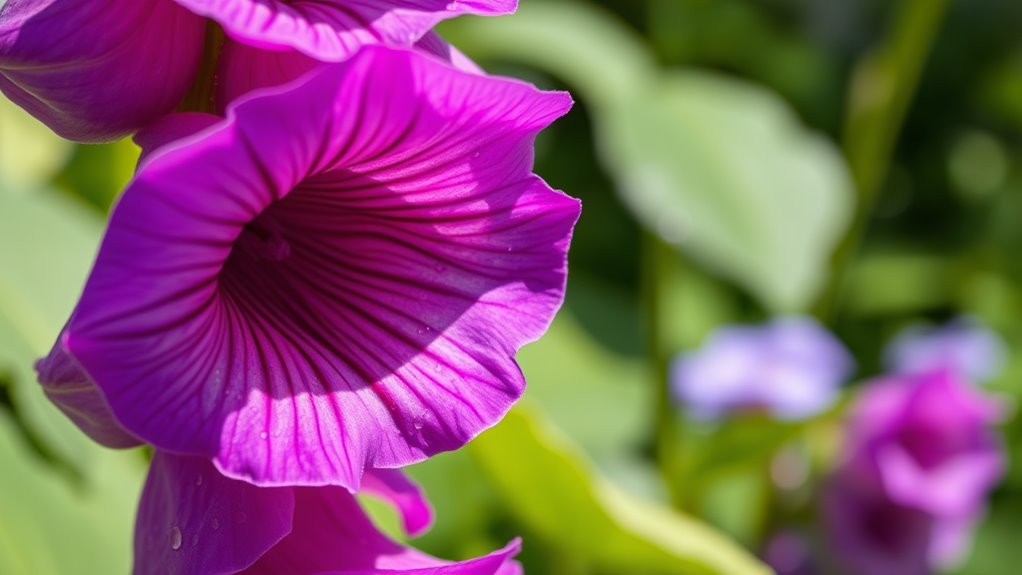This Forgotten Flower Will Make Your Garden Pop With Color
You’ll transform your garden with this forgotten flower, bursting with fiery oranges, deep purples, and subtle yellows that effortlessly draw pollinators like bees and butterflies. Choose well-draining soil in a sunny spot, plant seeds at the correct depth, and water gently while spacing plants 12 inches apart for ideal growth. Its drought-resistant nature minimizes maintenance, making it ideal for borders or containers. Master these strategies next to cultivate a thriving, colorful display.
Discovering the Forgotten Flower
Have you ever wondered how to uncover the forgotten flower in your garden?
To find unique flowers to grow, you first research lesser-known species that thrive in your region. Assess soil quality, sunlight exposure, and water availability. Prepare the planting area by removing weeds and adding compost. Sow seeds at the correct depth, water gently, and protect from extreme weather. Track their development and prune as necessary for healthy plants. Incorporating exquisite flowers into your garden can elevate its elegance and charm.
Its Vibrant Color Palette
One of the most striking features of the forgotten flower is its vibrant color palette, which includes shades like fiery oranges, deep purples, and subtle yellows that adapt to local light conditions.
This creates vivid imagery for you:
- Imagine fiery oranges glowing like a sunset, brightening your garden’s early hours with warm intensity.
- See deep purples providing elegant contrast, enhancing the visual depth of your floral scenes.
- Observe subtle yellows shifting with sunlight, adding a dynamic, lively layer to your outdoor space. Additionally, these colors can attract various pollinators, enhancing your garden’s natural ecosystem.
Planting Essentials for Success
To plant the forgotten flower successfully, you’ll select well-draining soil, choose a sunny spot, and time your efforts with the local growing season for best results.
Dig holes twice the root ball’s depth, space plants 12 inches apart for airflow, and water thoroughly right after planting.
Monitor for pests early, use organic mulch to retain moisture, and fertilize sparingly with balanced nutrients to promote healthy growth. Additionally, performing a soil test will help you identify any nutrient deficiencies or pH imbalances that may affect your plants.
Unique Characteristics and Uses
With your forgotten flower established in the garden, it showcases distinctive traits like drought-resistant foliage and vibrant, long-blooming petals that draw pollinators.
This flower has several practical uses that you’ll appreciate:
- Its drought-resistant leaves thrive in harsh conditions, minimizing your watering efforts while maintaining greenery.
- Vibrant petals provide natural dyes for crafts, offering colorful, eco-friendly options for your projects.
- Blooms attract bees and butterflies, enhancing local pollination and supporting your garden’s health. Additionally, these low-maintenance flowers are perfect for busy gardeners looking to simplify their gardening routine.
Creative Garden Integration Ideas
How can you creatively integrate this forgotten flower into your garden? Begin with border planting to define edges, using its vibrant hues for structure. Opt for containers on patios for easy mobility, or mix it into beds for diverse color pops. For vertical designs, train it on trellises to maximize space efficiently. Additionally, consider plant selection to ensure that the forgotten flower complements other plants in your garden.
| Integration Idea | Key Benefits | Practical Tips |
|---|---|---|
| Border Planting | Defines boundaries | Space plants 12 inches apart |
| Container Use | Portable displays | Select well-draining pots |
| Mixed Beds | Boosts variety | Pair with perennials |
| Focal Points | Draws attention | Group in clusters of three |
| Vertical Gardens | Saves ground space | Use sturdy supports |
Ongoing Care and Maintenance Tips
Regularly tending to your forgotten flower keeps it healthy and blooming vibrantly.
You’ll need to monitor its needs closely for ideal growth.
Here’s how to maintain it effectively:
-
Check soil moisture weekly: Probe the top inch; water deeply if it’s dry, picturing roots absorbing nutrients like a thirsty sponge.
-
Prune faded blooms monthly: Snip dead flowers with clean shears, envisioning new buds emerging in a cascade of color.
-
Inspect for pests regularly: Spot aphids or diseases early, imagining a shield protecting vibrant petals from unseen threats.

